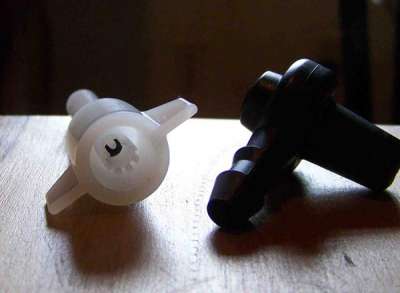The big buzz this spring in maple sugarmaking circles involves the new check-valve spouts that many sugarmakers with vacuum systems are trying for the first time.
The spiles were invented by Tim Perkins at the University of Vermont’s Proctor Maple Research Center. According to Perkins, in the spring of 2009, the spouts produced a seasonal total of 44.6 gallons of sap per tap on high vacuum (23.5 inches). This sap boiled down to make 1.09 gallons of syrup per tap – a 50 to 70 percent increase from what the bush had produced the year before. Conventional wisdom holds that an efficient producer should make between 1 quart and ½ gallon of syrup per tap in a good year.
It should be noted that the sugarbush these spouts were tested in was a top-ofthe- line operation (brand new drop lines, only one to three taps per lateral), and that last year was a great sugaring year in the Proctor microclimate. There’s also at least a perceived conflict of interest in the fact that Proctor both produced and tested the spouts. Still, sugarmakers are excited about the promise of the new technology; even if a layman only gets 30 to 50 percent more sap per tap, we’re still talking large production gains.
The science behind the new spout is surprisingly simple. As the name suggests, the spout contains a check valve – a tiny plastic ball that rolls forward and backward within the unit. When the sap is flowing, the ball lies between plastic fingers on the dropline side of the spout, thus allowing sap to flow around it and into a tubing system. When the sap is running backwards, however, the ball valve shoots forward, towards the tree, and seals the operating end of the spout, thus keeping sap from backwashing into the tree. This prevents microbial contamination in the taphole. A cleaner taphole extends the sap-flow period, thus the big production increase.
If you’re not familiar with vacuumized tubing systems, you’ll wonder why sap would run backwards through a sap line. What happens is negative pressure develops inside the tree after a vacuum pump has been running for an extended period of time. At the end of the day, if you shut off the pump before freeze-up, any liquid that’s in your lines will be drawn backwards into the tree. This can happen on a smaller scale if a leak develops in a line, or each time your releaser dumps, as it does regularly in normal operating conditions.
Other spile buzz involves nano-particle technology. Inventor Tom Kaufman is working with Agion Technologies Corporation to manufacture plastic spouts that contain silver – reportedly a natural anti-microbial agent. Some of these spouts are already on the market, but there’s some question among sugarmakers as to whether the anti-bacterial properties are effective for more than one season. Kaufman says he’s at work tweaking the spile design, and that an updated version is being tested this spring by a university sugaring program.


